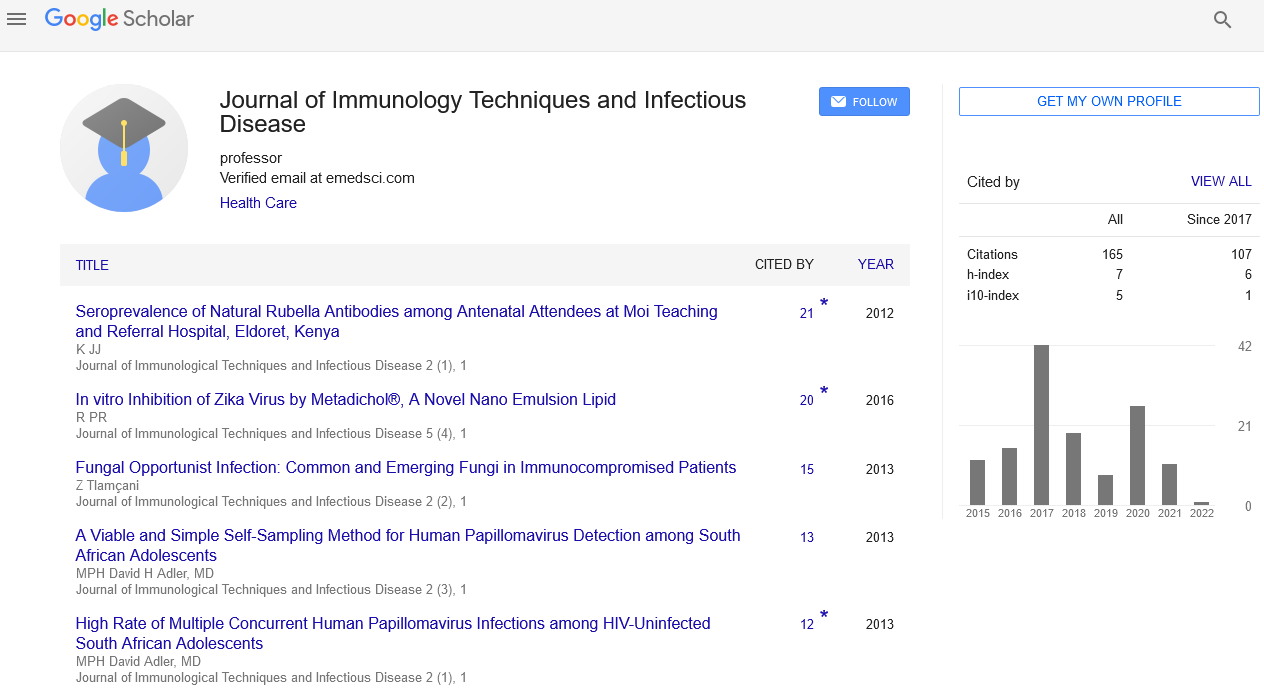Opinion Article, J Immunol Tech Infect Dis Vol: 12 Issue: 2
Lateral Flow Immunochromatographic Assay: A Rapid and Reliable Diagnostic Tool
Aqael Shan*
1Department of Microbiology, University of Karachi, Karachi, Pakistan
*Corresponding Author: Aqael Shan,
Department of Microbiology, University of
Karachi, Karachi, Pakistan
E-mail: aqaelshan@gmail.com
Received date: 29 May, 2023, Manuscript No. JIDIT-23-105439;
Editor assigned date: 31 May, 2023, PreQC No. JIDIT-23-105439 (PQ);
Reviewed date: 14 June, 2023, QC No. JIDIT-23-105439;
Revised date: 21 June, 2023, Manuscript No. JIDIT-23-105439 (R);
Published date: 28 June, 2023, DOI: 10.4172/2329-9541.1000346.
Citation: Shan A (2023) Lateral Flow Immunochromato-graphic Assay: A Rapid and Reliable Diagnostic Tool. J Immunol Tech Infect Dis 12:2.
Description
The field of diagnostic testing has witnessed significant advancements in recent years, aiming to provide rapid and accurate results to aid in disease detection. One such innovative technique is the lateral flow immunochromatographic assay, commonly known as the lateral flow test. Lateral flow immunochromatogarphic assays are based on the principles of immunoassay techniques, utilizing the specific interaction between antigens and antibodies. These assays employ a porous membrane, usually made of nitrocellulose, as the solid phase for the detection of target analytes. The membrane is coated with specific antibodies or antigens, depending on the purpose of the test.
The lateral flow assay consists of three main components: the sample pad, the conjugate pad, and the detection zone. The sample pad is where the test sample is applied, and it facilitates the flow of the sample through the membrane. The conjugate pad contains labeled antibodies or antigens that bind to the target analyte. The detection zone consists of immobilized antibodies or antigens that capture the target analyte-antibody or antigen-antibody complexes, producing visible signals, such as colored lines.
The working mechanism of lateral flow immunochromatographic assays is simple and efficient. When a sample is applied to the sample pad, it flows along the membrane due to capillary action. As the sample reaches the conjugate pad, the labeled antibodies or antigens bind to the target analyte, forming a complex. This complex migrates further along the membrane until it reaches the detection zone.
In the detection zone, the immobilized antibodies or antigens capture the target analyte-antibody or antigen-antibody complexes, resulting in the formation of visible lines. These lines indicate a positive result, demonstrating the presence of the target analyte in the sample. The intensity of the lines can also provide quantitative information about the analyte concentration.
Lateral flow immunochromatographic assays offer several advantages that make them popular in diagnostic testing. Firstly, they provide rapid results, typically within minutes, enabling on-site testing and immediate decision-making. They are simple to use, requiring minimal training and equipment, making them suitable for resourcelimited settings and point-of-care applications.
Furthermore, lateral flow assays have a long shelf life and do not require complex storage conditions, enhancing their practicality. They are also highly portable, allowing for easy transportation to remote areas or during emergency situations. Moreover, these assays can detect multiple analytes simultaneously, thanks to the availability of multiplexing techniques, making them versatile for a wide range of applications, including infectious disease diagnostics, food safety, veterinary medicine, and environmental monitoring.
Lateral flow immunochromatographic assays have found extensive applications in various fields. In the realm of infectious disease diagnostics, they have been utilized for rapid screening and detection of pathogens such as Human Immunodeficiency Viruses (HIV), malaria, influenza, and COVID-19. These assays have played an important role during the COVID-19 pandemic, enabling mass testing and prompt identification of infected individuals.
The food industry has also benefited from lateral flow assays, as they facilitate the detection of contaminants, allergens, and adulterants in food products, ensuring consumer safety. Veterinary medicine has adopted lateral flow tests for the diagnosis of animal diseases, including bovine tuberculosis and parvovirus infections. Additionally, environmental monitoring applications involve the detection of pollutants and toxins in water, air, and soil using lateral flow assays.
Despite their numerous advantages, lateral flow immunochromatographic assays face certain limitations. One of the main challenges is their sensitivity compared to laboratory-based techniques like Enzyme- Linked Immunosorbent Assays (ELISA). However, ongoing research and development efforts aim to enhance their sensitivity by incorporating novel detection strategies and amplification methods.
The future of lateral flow immunochromatographic assays looks promising, with ongoing advancements in the field. Scientists are exploring the integration of smartphone-based imaging and artificial intelligence algorithms to improve result interpretation and quantification. The development of more sensitive and specific detection molecules, such as recombinant antibodies and aptamers, also holds great potential.
Conclusion
Lateral flow immunochromatographic assays have revolutionized diagnostic testing by offering rapid and reliable results in a userfriendly format. Their simplicity, portability, and versatility make them indispensable in various fields, from infectious disease diagnostics to food safety and environmental monitoring. While challenges remain in terms of sensitivity, ongoing research efforts are continuously improving the performance of lateral flow assays advance in technology and scientific knowledge, lateral flow immunochromatographic assays are poised to play an even more significant role in the future of diagnostic medicine.
 Spanish
Spanish  Chinese
Chinese  Russian
Russian  German
German  French
French  Japanese
Japanese  Portuguese
Portuguese  Hindi
Hindi 
